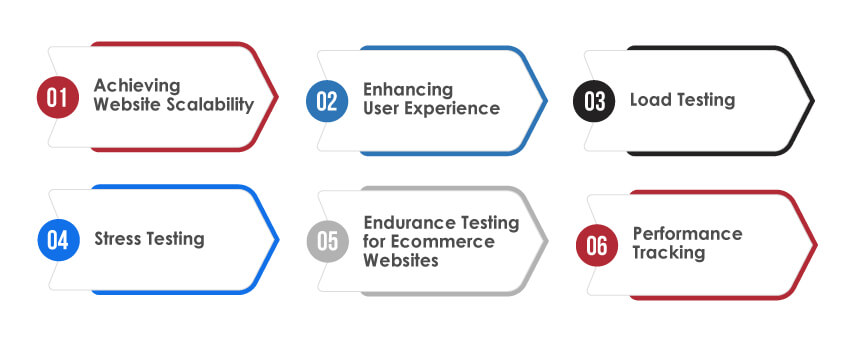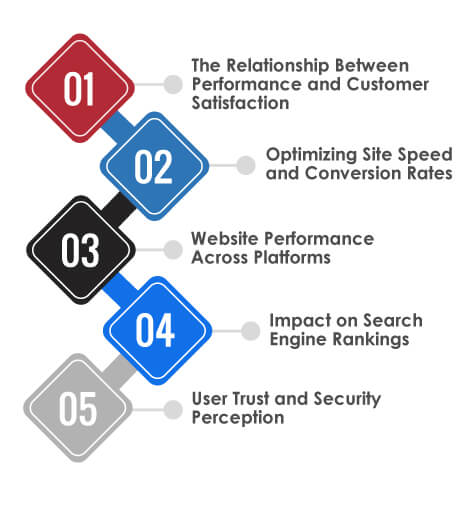Recommended Blogs
Role of eCommerce Performance Testing in Driving Business Growth

Table of Contents
- Importance of eCommerce Performance Testing
- The Impact of Performance on User Experience
- Best Practices in eCommerce Performance Testing
- Measuring the Impact of Performance Testing on Business ROI
- Conclusion
- How Can TestingXperts Help with eCommerce Performance Testing?
The eCommerce industry has seen considerable expansion in recent years, globally transforming retail. This growth spans conventional markets like North America and Asia Pacific as well as diverse geographies such as developing economies. One notable pattern in this expansion involves the rising significance of classes that have traditionally observed little eCommerce revenue. While these classes remain at the outset of web-based buying, they show robust growth potential.
Additionally, social networking platforms have become a primary site for product discovery and conversions. Sites like Instagram, Facebook, and TikTok are not merely traffic generators but also essential participants in sales conversion. A considerable segment of eCommerce retailers’ promotional and marketing expenditures is devoted to these platforms. The blending of influencer marketing, particularly in a setting of economic unpredictability, is anticipated to be a substantial investment for brands in the forthcoming years.
Within the eCommerce sphere, a diversification of payment options is occurring. Moving beyond conventional credit and debit cards, third-party services such as PayPal, Apple Pay, and even cryptocurrencies are accumulating approval, supplying shoppers more adaptability and potentially diminishing retailer transaction expenses. Another popular trend is utilizing videos and Augmented Reality to enhance the online purchasing experience. Brands progressively use these technologies to involve clients, showcase products, and facilitate a more immersive and interactive shopping encounter.
The constant transformation of the eCommerce industry highlights the necessity for performance testing. As online merchants attempt to cater to an expanding and diverse worldwide market, confirming ideal website performance becomes critical. Performance testing addresses not just the technical facets of an eCommerce platform but also plays a pivotal function in improving user experience, consequently contributing substantially to business expansion and customer loyalty.
Importance of eCommerce Performance Testing
Ecommerce websites need to function smoothly and efficiently for customers. Performance testing evaluates how well a site operates under different situations and usage levels to make sure it meets performance goals. Several important parts make performance testing significant for eCommerce, such as:

Achieving Website Scalability
One of the fundamental aspects involves evaluating an eCommerce site’s scalability capacity. This requires experimentally examining the website’s power to manage heightened traffic loads, notably during peak purchasing seasons, for example, Black Friday, Cyber Monday, or festive vacations. Scalability testing confirms that the website continues to be accessible and steady, even under the weight of abrupt traffic spikes, which regularly occur in the eCommerce area.
Enhancing User Experience
The main focus of performance testing in industries is to optimizing how users experience a website. Factors like loading speed, responsiveness, and seamless transaction processing directly impact customer satisfaction and loyalty. Pages that load slowly or interfaces that glitch can spike bounce rates and reduce sales, as modern customers expect quick and hassle-free online shopping experiences.
Load Testing
Subjecting a website to typical and peak load conditions through load testing is a critical component of evaluating its performance under different usage scenarios. This process aims to determine the maximum operating capacity of the site and provide insight into how it responds when traffic varies. Load testing also helps uncover any bottlenecks that may disrupt user experience by saturating the website with incremental loads. The results expose weaknesses unable to withstand heavier site usage and inform where optimization is needed most to ensure smooth functionality even during times of heightened activity.
Stress Testing
Stress testing examines how a website functions when pushed beyond its typical workload. The goal is to observe how the site responds under extraordinary circumstances, vital for readying for unforeseen surges in traffic or utilization. This assists with comprehending the website’s limit and failure modes, fundamental for strength and flexibility.
Endurance Testing for Ecommerce Websites
Subjecting an online store to substantial traffic over an extended timeframe is known as endurance or soak testing. This process exposes the site to prolonged stress, typically 6-72 hours. The goal is to assess how well the platform withstands constant usage without facing performance issues down the line. By maintaining peak operation under sustained load, endurance testing confirms the site can deliver a smooth shopping experience for users consistently even with elevated site traffic over days.
Performance Tracking
Constant performance tracking is another crucial part. It involves routinely checking the site’s functioning to detect and fix issues proactively. This ongoing process helps uphold the eCommerce platform’s quality and dependability. It also permits real-time understanding of how changes or updates influence site performance, guaranteeing that any alterations improve, rather than detract from, the user experience.
The Impact of Performance on User Experience
How efficiently an online store or application functions directly impacts the consumer experience. This relationship between the technical functionality of an eCommerce site or mobile app and how customers see and use the platform is essential for business success.

The Relationship Between Performance and Customer Satisfaction
How smoothly and promptly an eCommerce site functions has a direct connection to user experience. Research has demonstrated that even a one-second lag in page load can notably decrease customer satisfaction. This dissatisfaction influences immediate sales and can damage brand allegiance and image over the long term.
Optimizing Site Speed and Conversion Rates
The loading speed of an e-commerce website significantly impacts conversion rates. Faster sites allow for smoother shopping experiences that encourage users to browse longer and make additional purchases. In contrast, slowly loading pages are a primary reason many abandon their carts before checking out. Ensuring your website loads promptly and efficiently is a technical requirement and wise business practice.
Website Performance Across Platforms
As mobile shopping grows, analyzing how well an online store function on varied devices and operating systems becomes crucial. A desktop-optimized site lagging on mobile or tablets risks losing customers. Responsive design and cross-platform testing help provide a consistently positive experience regardless of a user’s chosen device. By adapting content and code for diverse screens, businesses can satisfy shoppers anywhere, seeking quick, smooth interactions.
Impact on Search Engine Rankings
Performance also influences an eCommerce site’s visibility on search engines. Search engines like Google consider site speed and user experience as ranking factors. A well-performing website is more likely to rank higher in search results, leading to increased visibility and traffic.
User Trust and Security Perception
Issues with performance can influence users’ trust in the safety and dependability of an eCommerce platform as well. Regular periods of being unavailable, slow transaction procedures, or pages that are sluggish to respond can stir up worries about the platform’s security, dissuading users from finishing transactions.
Best Practices in eCommerce Performance Testing
It is imperative to implement optimal practices in eCommerce performance testing to guarantee an online store can proficiently and dependably meet the demands of its customers. Let us explore the principal strategies and tactics to contemplate in the performance testing procedure.

Developing a Thorough Testing Plan
Creating a complete testing plan involves recognizing the exact aims and objectives of performance testing. For instance, deciding whether the focus is on dealing with high traffic during sales promotions, guaranteeing smooth checkout processes function correctly, or maintaining consistent function across various devices and web browsers. These aims should correspond with the business goals, such as boosting conversion rates, decreasing bounce rates, or improving customer satisfaction ratings.
Defining Crucial Metrics
The strategy must also pinpoint pivotal metrics (KPIs) like webpage load time, server response speed, and mistake rates. Comprehending the customer experience is vital to guarantee that all user routes, particularly the high-traffic and crucial transaction paths, are completely evaluated. It concerns evaluating the homepage and confirming that product pages, search capabilities, and checkout procedures are optimized for efficiency.
Choosing the Right Tools and Technologies
The choice of tools and technologies for performance testing can significantly impact the effectiveness of the process. This decision should be based on several factors, including the complexity of the eCommerce site, the technology stack used, and the specific testing needs. For instance, tools like Apache JMeter, LoadRunner, or WebLoad are popular for simulating high traffic levels and analyzing performance under load. Moreover, choosing tools that can simulate real user behavior as closely as possible is essential. This includes testing from different geographical locations, using various devices and browsers, and simulating different types of user interactions. The tools should also provide comprehensive analytics to help identify bottlenecks and understand performance under different conditions.
Integrating Performance Testing into the Software Development Lifecycle
Performance testing should be conducted at each phase of software development. This technique, often part of Agile and DevOps methodologies, guarantees that execution is considered a constant aspect instead of an afterthought. For example, when new capabilities are created, execution tests ought to be run simultaneously to verify that these progressions do not contrarily influence the site’s execution. This can be accomplished through CI/CD practices, where code changes are tested and deployed automatically. This methodology assists with recognizing execution issues ahead of schedule and encourages brief remedy, diminishing the expense and time related with execution related enhancements and fixes.
Post-Launch Site Monitoring
Once the online store is launches, consistent monitoring is critical to confirming it functions as planned. This includes following various performance measures in real-time and establishing notices for any irregularities or performance decreases. This persistent (24/7) monitoring assists in rapidly recognizing and deal with problems like server downtimes, slow page loads, or transaction failures. It also offers useful understandings into how genuine users connect with the site, which can be utilized to optimize performance and client experience additionally.
Maintaining a High-Performing Ecommerce Platform
Consistently analyzing and refining the online store is crucial to sustaining strong functionality. Performance statistics are examined to find areas for enhancement, then adjustments are implemented. The website code may be streamlined, server settings optimized, or content delivery refined. Updates derive from thorough reviews of metrics and user commentary. Steady betterment helps maintain a swift, responsive marketplace meeting customer needs and technological shifts. No stagnation allows expectations to surpass capabilities.
A Focus on Users
Taking a user-centered approach to performance testing means concentrating on elements that immediately impact how users experience an application. This involves quantifying technical indicators like load durations or response speeds and contemplating how these variables shape what users think and do. For instance, recognizing how rapidly pages fill influences whether users remain engaged, complete purchases, or depart quickly. This methodology guarantees that performance testing aims to supply users with a seamless, efficient, and pleasurable shopping experience.
Measuring the Impact of Performance Testing on Business ROI
Comprehending the effect of functionality trials on the comeback on speculation (ROI) is fundamental for all online business ventures. This includes breaking down how enhancements in execution because of exhaustive testing convert into quantifiable business advantages.

Key Performance Indicators for Measuring ROI
To effectively measure the return on investment (ROI) from performance testing in eCommerce, businesses should concentrate on specific Key Performance Indicators (KPIs). These KPIs include Page Load Time, which is crucial for user experience, where faster load times can enhance user engagement and lower bounce rates. Conversion Rates are also vital, as they are closely linked to site performance. Improvements in site responsiveness can lead to higher conversion rates. Additionally, User Engagement Metrics such as session duration, pages per session, and return visits indicate how performance enhancements impact the user experience.
Evaluating Financial Impact
One of the methods for measuring the return on investment of performance testing is through revenue analysis. This involves contrasting revenue figures before and following improvements to performance. Revenue growth frequently aligns with enhancements to website speed and usability, signifying a positive return on investment.
Achieving Cost Effectiveness Through Optimal Functioning
Testing performance can result in cost reductions, a pivotal part of return on investment. By finding and fixing performance problems, companies can prevent expensive shutdowns and lessen the need for pricey infrastructure improvements. These cost reductions must be considered in the total return on investment computation.
Impact on Customer Satisfaction and Brand Reputation
Enhancing customer satisfaction and maintaining a positive brand reputation can notably contribute to return on investment, though these benefits may be more abstract to measure directly. A quick and dependable eCommerce website or mobile app has the power to strengthen consumer loyalty and result in favorable word-of-mouth advertising. This informal promotion through satisfied shoppers is an extremely important resource that can sustain long-term organizational progress.
Extended Gains
The return on investment of performance testing should also consider prolonged advantages. This involves the scalability of the eCommerce platform, its capacity to manage potential traffic surges moving forward, and the lessened necessity for regular significant renovations.
Determining Return on Investment
To determine return on investment, companies must contemplate direct fiscal increases (for example, amplified sales and reduced expenditures) alongside intangible advantages (such as enhanced client satisfaction and a more prominent brand image). This assessment regularly contrasts the expenses related to effectiveness testing (including devices, assets, and time) with the fiscal and non-budgetary increases accomplished.
Conclusion
An effective performance evaluation directly affects user experience, transformation rates, and business revenue. eCommerce platforms can substantially improve their performance by executing various techniques, for example, comprehensive testing strategies, selecting rights tools, and coordinating testing into the development lifecycle. Regular observation and optimization dependent on KPIs are fundamental for maintaining a top-notch user experience. As the eCommerce industry keeps on advancing and developing, prioritizing performance testing is not simply a specialized necessity however a strategic venture that drives client satisfaction and business achievement.
Discover more
Stay Updated
Subscribe for more info
